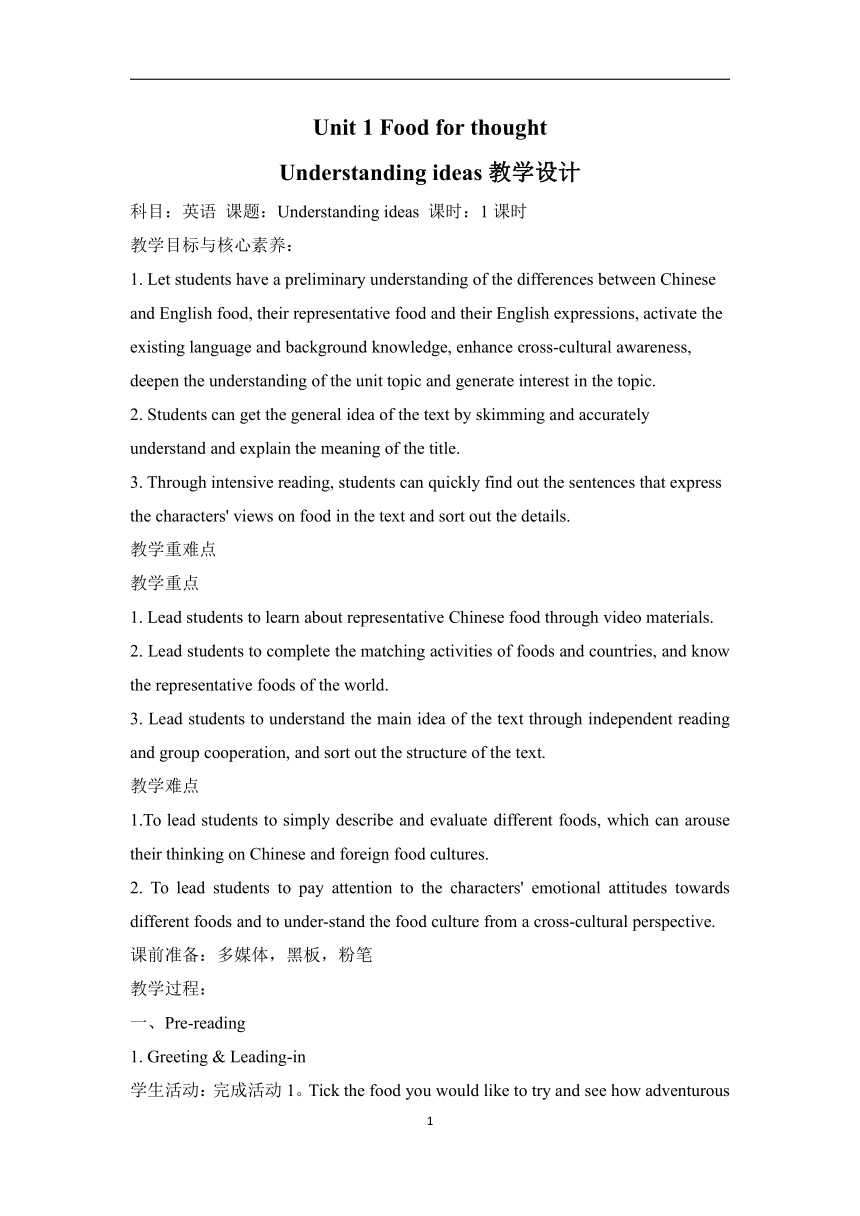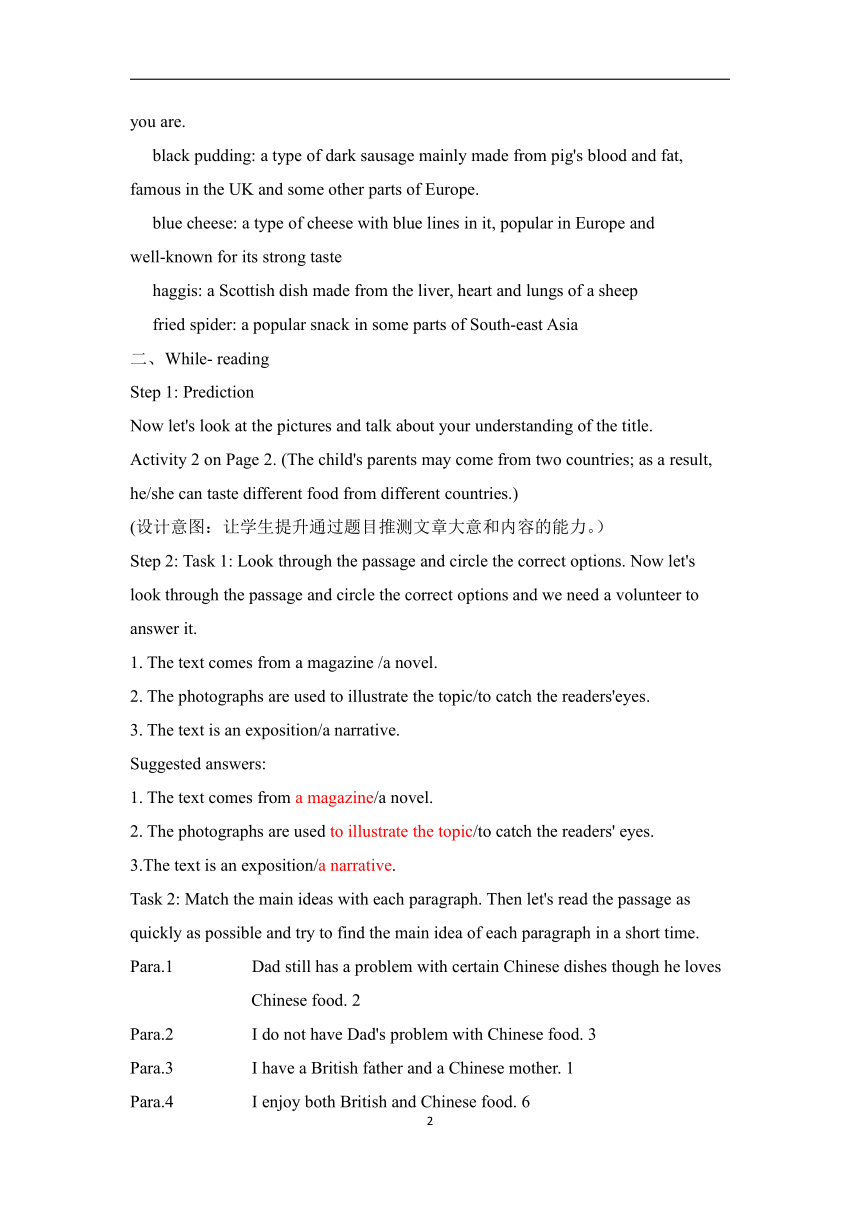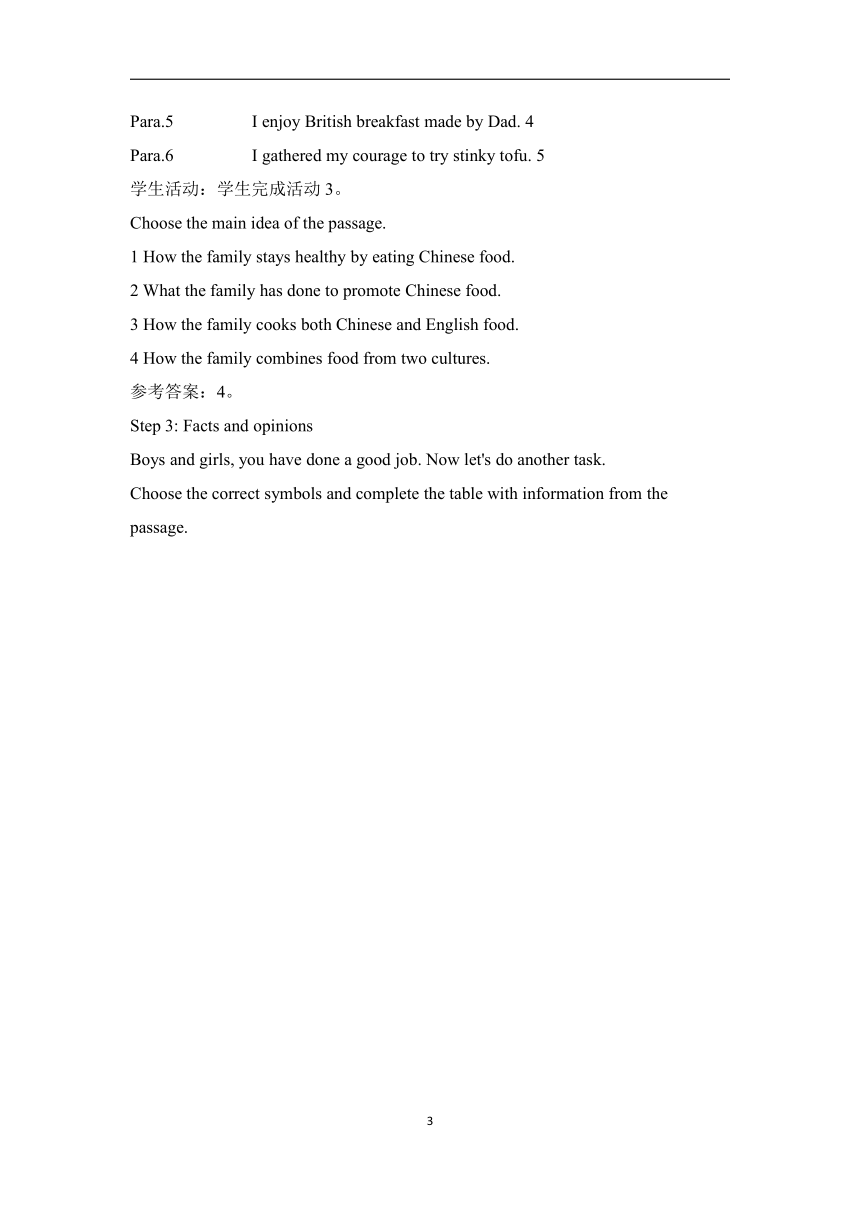外研版(2019)必修第二册Unit 1 Food for thought Section A Starting out&Understanding ideas教案
文档属性
| 名称 | 外研版(2019)必修第二册Unit 1 Food for thought Section A Starting out&Understanding ideas教案 |  | |
| 格式 | docx | ||
| 文件大小 | 50.2KB | ||
| 资源类型 | 教案 | ||
| 版本资源 | 外研版(2019) | ||
| 科目 | 英语 | ||
| 更新时间 | 2022-10-22 12:34:34 | ||
图片预览



文档简介
Unit 1 Food for thought
Understanding ideas教学设计
科目:英语 课题:Understanding ideas 课时:1课时
教学目标与核心素养:
1. Let students have a preliminary understanding of the differences between Chinese and English food, their representative food and their English expressions, activate the existing language and background knowledge, enhance cross-cultural awareness, deepen the understanding of the unit topic and generate interest in the topic.
2. Students can get the general idea of the text by skimming and accurately understand and explain the meaning of the title.
3. Through intensive reading, students can quickly find out the sentences that express the characters' views on food in the text and sort out the details.
教学重难点
教学重点
1. Lead students to learn about representative Chinese food through video materials.
2. Lead students to complete the matching activities of foods and countries, and know the representative foods of the world.
3. Lead students to understand the main idea of the text through independent reading and group cooperation, and sort out the structure of the text.
教学难点
1.To lead students to simply describe and evaluate different foods, which can arouse their thinking on Chinese and foreign food cultures.
2. To lead students to pay attention to the characters' emotional attitudes towards different foods and to under-stand the food culture from a cross-cultural perspective.
课前准备:多媒体,黑板,粉笔
教学过程:
一、Pre-reading
1. Greeting & Leading-in
学生活动:完成活动1。Tick the food you would like to try and see how adventurous you are.
black pudding: a type of dark sausage mainly made from pig's blood and fat, famous in the UK and some other parts of Europe.
blue cheese: a type of cheese with blue lines in it, popular in Europe and well-known for its strong taste
haggis: a Scottish dish made from the liver, heart and lungs of a sheep
fried spider: a popular snack in some parts of South-east Asia
While- reading
Step 1: Prediction
Now let's look at the pictures and talk about your understanding of the title.
Activity 2 on Page 2. (The child's parents may come from two countries; as a result, he/she can taste different food from different countries.)
(设计意图:让学生提升通过题目推测文章大意和内容的能力。)
Step 2: Task 1: Look through the passage and circle the correct options. Now let's look through the passage and circle the correct options and we need a volunteer to answer it.
1. The text comes from a magazine /a novel.
2. The photographs are used to illustrate the topic/to catch the readers'eyes.
3. The text is an exposition/a narrative.
Suggested answers:
1. The text comes from a magazine/a novel.
2. The photographs are used to illustrate the topic/to catch the readers' eyes.
3.The text is an exposition/a narrative.
Task 2: Match the main ideas with each paragraph. Then let's read the passage as quickly as possible and try to find the main idea of each paragraph in a short time.
Para.1 Dad still has a problem with certain Chinese dishes though he loves Chinese food. 2
Para.2 I do not have Dad's problem with Chinese food. 3
Para.3 I have a British father and a Chinese mother. 1
Para.4 I enjoy both British and Chinese food. 6
Para.5 I enjoy British breakfast made by Dad. 4
Para.6 I gathered my courage to try stinky tofu. 5
学生活动:学生完成活动3。
Choose the main idea of the passage.
1 How the family stays healthy by eating Chinese food.
2 What the family has done to promote Chinese food.
3 How the family cooks both Chinese and English food.
4 How the family combines food from two cultures.
参考答案:4。
Step 3: Facts and opinions
Boys and girls, you have done a good job. Now let's do another task.
Choose the correct symbols and complete the table with information from the passage.
Sichuan hot pot Opinion
Supporting details Mum has sweet memories of the food from her home town in Sichuan, and often cooks spicy dishes. Thanks to this, Dad has come to love hot pot!
Animal parts Opinion
Supporting details Even today, he still does not easily take to eating things like chicken feet. But I enjoy that sort of food myself.
Full English breakfast Opinion
Supporting details
Sunday roast Opinion
Supporting details We all love roast beef and vegetables... We all love roast beef and vegetables... We all love roast beef and vegetables...
Stinky tofu Opinion
Supporting details But just when I thought I could deal with all Chinese food, I came across stinky tofu, a horrible grey thing...
Step 4: T lets Ss find out the characters' attitudes towards Chinese/British food
Dad: acceptable (love, but, dare not, surprised, shocked, still, not easily take to);
Mum: rational (often cook spicy food, love, but, had better not, too much, suffer from);
I: positive (super, typical, love);
I: positive &. curious (enjoy, never forget, gather the courage, amazed, maybe, fall in love).
* must have thought I was joking
* there is nothing better than...
Go through the words and expressions discussed and put them in groups according to the context.
本环节主要是让学生从课文中找出表达感情和观点的词组或者单词,学会运用表达感情的词汇。为以后的文章续写奠定基础。
Step 5: Choose the best answer
Then, let's think about another question-what is the function of the last paragraph What is the function of the last paragraph
A. To emphasize the author's preference for tea.
B. To explain how the author feels at home.
C. To respond to the opening paragraph.
D. To convey the author's understanding of poison.
Suggested answer: C
Can you make a summary of the passage and fill in the blanks
The narrator, a Chinese-British boy, enjoys both Chinese and British cuisines. Unlike his British father, who loves Chinese food but still has a fear of certain dishes, he is open to Chinese diet challenges he has come across. His adaptation, positive behaviors and attitude towards the cross-cultural environment have benefited him, so that he is able to combine and blend aspects of both British and Chinese cultures in an enjoyable way.
Step 6: Critical thinking
Now it's thinking time. Let's think about the following questions and have a 10-minute group discussion about them. Then I will ask some volunteers to show your answers.
1. How do you understand “one man's meat is another man's poison”
2. Do you think it is true that “we are what we eat”
I think it is true because...For example,…
本环节引导学生进一步了解本节课的主题和意义,提升学生的批判性思维和解决问题的能力。
三、After-reading
1: Are they our food OK, everyone has done a good job. Now let's look at the following pictures and talk about what we should do in our daily life.
【Show some pictures of bushmeat(野味)as special dinner for some people.】
Let the students think about if bushmeat is good for us and what should they do.
1. What are the pictures about
2. Do you love this kind of food What's your feeling when looking at these pictures
3. Why do some people love to eat this kind of disgusting and terrifying bushmeat
4. Do you know the consequence of eating them (such as the bats)
四、Summary
总结本节课所学。
五、Homework
1. Sum up what they learned in class and take notes.
2. Preview the next period.
2
Understanding ideas教学设计
科目:英语 课题:Understanding ideas 课时:1课时
教学目标与核心素养:
1. Let students have a preliminary understanding of the differences between Chinese and English food, their representative food and their English expressions, activate the existing language and background knowledge, enhance cross-cultural awareness, deepen the understanding of the unit topic and generate interest in the topic.
2. Students can get the general idea of the text by skimming and accurately understand and explain the meaning of the title.
3. Through intensive reading, students can quickly find out the sentences that express the characters' views on food in the text and sort out the details.
教学重难点
教学重点
1. Lead students to learn about representative Chinese food through video materials.
2. Lead students to complete the matching activities of foods and countries, and know the representative foods of the world.
3. Lead students to understand the main idea of the text through independent reading and group cooperation, and sort out the structure of the text.
教学难点
1.To lead students to simply describe and evaluate different foods, which can arouse their thinking on Chinese and foreign food cultures.
2. To lead students to pay attention to the characters' emotional attitudes towards different foods and to under-stand the food culture from a cross-cultural perspective.
课前准备:多媒体,黑板,粉笔
教学过程:
一、Pre-reading
1. Greeting & Leading-in
学生活动:完成活动1。Tick the food you would like to try and see how adventurous you are.
black pudding: a type of dark sausage mainly made from pig's blood and fat, famous in the UK and some other parts of Europe.
blue cheese: a type of cheese with blue lines in it, popular in Europe and well-known for its strong taste
haggis: a Scottish dish made from the liver, heart and lungs of a sheep
fried spider: a popular snack in some parts of South-east Asia
While- reading
Step 1: Prediction
Now let's look at the pictures and talk about your understanding of the title.
Activity 2 on Page 2. (The child's parents may come from two countries; as a result, he/she can taste different food from different countries.)
(设计意图:让学生提升通过题目推测文章大意和内容的能力。)
Step 2: Task 1: Look through the passage and circle the correct options. Now let's look through the passage and circle the correct options and we need a volunteer to answer it.
1. The text comes from a magazine /a novel.
2. The photographs are used to illustrate the topic/to catch the readers'eyes.
3. The text is an exposition/a narrative.
Suggested answers:
1. The text comes from a magazine/a novel.
2. The photographs are used to illustrate the topic/to catch the readers' eyes.
3.The text is an exposition/a narrative.
Task 2: Match the main ideas with each paragraph. Then let's read the passage as quickly as possible and try to find the main idea of each paragraph in a short time.
Para.1 Dad still has a problem with certain Chinese dishes though he loves Chinese food. 2
Para.2 I do not have Dad's problem with Chinese food. 3
Para.3 I have a British father and a Chinese mother. 1
Para.4 I enjoy both British and Chinese food. 6
Para.5 I enjoy British breakfast made by Dad. 4
Para.6 I gathered my courage to try stinky tofu. 5
学生活动:学生完成活动3。
Choose the main idea of the passage.
1 How the family stays healthy by eating Chinese food.
2 What the family has done to promote Chinese food.
3 How the family cooks both Chinese and English food.
4 How the family combines food from two cultures.
参考答案:4。
Step 3: Facts and opinions
Boys and girls, you have done a good job. Now let's do another task.
Choose the correct symbols and complete the table with information from the passage.
Sichuan hot pot Opinion
Supporting details Mum has sweet memories of the food from her home town in Sichuan, and often cooks spicy dishes. Thanks to this, Dad has come to love hot pot!
Animal parts Opinion
Supporting details Even today, he still does not easily take to eating things like chicken feet. But I enjoy that sort of food myself.
Full English breakfast Opinion
Supporting details
Sunday roast Opinion
Supporting details We all love roast beef and vegetables... We all love roast beef and vegetables... We all love roast beef and vegetables...
Stinky tofu Opinion
Supporting details But just when I thought I could deal with all Chinese food, I came across stinky tofu, a horrible grey thing...
Step 4: T lets Ss find out the characters' attitudes towards Chinese/British food
Dad: acceptable (love, but, dare not, surprised, shocked, still, not easily take to);
Mum: rational (often cook spicy food, love, but, had better not, too much, suffer from);
I: positive (super, typical, love);
I: positive &. curious (enjoy, never forget, gather the courage, amazed, maybe, fall in love).
* must have thought I was joking
* there is nothing better than...
Go through the words and expressions discussed and put them in groups according to the context.
本环节主要是让学生从课文中找出表达感情和观点的词组或者单词,学会运用表达感情的词汇。为以后的文章续写奠定基础。
Step 5: Choose the best answer
Then, let's think about another question-what is the function of the last paragraph What is the function of the last paragraph
A. To emphasize the author's preference for tea.
B. To explain how the author feels at home.
C. To respond to the opening paragraph.
D. To convey the author's understanding of poison.
Suggested answer: C
Can you make a summary of the passage and fill in the blanks
The narrator, a Chinese-British boy, enjoys both Chinese and British cuisines. Unlike his British father, who loves Chinese food but still has a fear of certain dishes, he is open to Chinese diet challenges he has come across. His adaptation, positive behaviors and attitude towards the cross-cultural environment have benefited him, so that he is able to combine and blend aspects of both British and Chinese cultures in an enjoyable way.
Step 6: Critical thinking
Now it's thinking time. Let's think about the following questions and have a 10-minute group discussion about them. Then I will ask some volunteers to show your answers.
1. How do you understand “one man's meat is another man's poison”
2. Do you think it is true that “we are what we eat”
I think it is true because...For example,…
本环节引导学生进一步了解本节课的主题和意义,提升学生的批判性思维和解决问题的能力。
三、After-reading
1: Are they our food OK, everyone has done a good job. Now let's look at the following pictures and talk about what we should do in our daily life.
【Show some pictures of bushmeat(野味)as special dinner for some people.】
Let the students think about if bushmeat is good for us and what should they do.
1. What are the pictures about
2. Do you love this kind of food What's your feeling when looking at these pictures
3. Why do some people love to eat this kind of disgusting and terrifying bushmeat
4. Do you know the consequence of eating them (such as the bats)
四、Summary
总结本节课所学。
五、Homework
1. Sum up what they learned in class and take notes.
2. Preview the next period.
2
